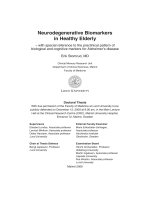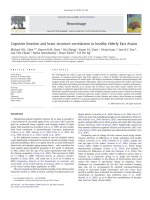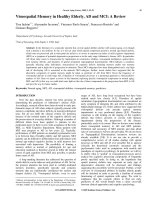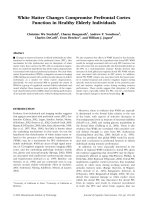Antioxidant capacity in relationship to serum lipid peroxides levels in healthy elderly of Mexico City* doc
Bạn đang xem bản rút gọn của tài liệu. Xem và tải ngay bản đầy đủ của tài liệu tại đây (37.36 KB, 6 trang )
Acta Bioquím Clín Latinoam 2004; 38 (2): 193-8
Summary
The aging is one of the factors that cause decrease in the antioxidant capac-
ity. Likewise, it has been proposed that subjects exposed permanently to air
pollution develop deficient antioxidant capacity to oxidative stress (OxS).
This study aimed to analyze the antioxidant capacity against elevated lipid
peroxides in healthy elderly of Mexico City. 105 adults (44 ± 10.8 years)
and 126 elderly subjects were studied (68 ± 7.1 years); residents of Mexico
City (clinically healthy, non-smokers, non-vitamin supplement takers) who
had lived in the city for >10 years. Plasma lipoperoxides (LPO), total antiox-
idant status (TAS), the activity of red blood cells superoxide dismutase
(SOD), and plasma glutathione peroxidase (GPx), were studied in all sub-
jects. LPO levels were found significantly higher (p < 0.05) in the elderly
subjects in comparison with the adults; in addition, TAS and GPx were high-
er in adults than among the elderly people (p < 0.0001). Nevertheless, SOD
was similar in both groups (p = 0.346). These findings reveal that the eld-
erly residents of Mexico City have TAS and GPx lower than adults, and simi-
lar SD activity, probably due to the fact that these antioxidants are neutral-
izing the higher LPO levels of elderly people. Therefore, this mechanism
could be considered as an efficient antioxidant capacity in the elderly, as
response to high LPO levels, since the health status, mortality prevalence
and life span life of the older people of Mexico City are similar or better than
other cities of Mexican Republic.
Key words: Adaptation to oxidative stress * total antioxidant status * elder-
ly people * pollution * superoxide dismutase * glutathione peroxidase.
Bioquímica Clínica
Antioxidant capacity in relationship to
serum lipid peroxides levels in healthy
elderly of Mexico City*
Martha A. Sánchez-Rodríguez
1
, Raquel Retana-Ugalde
1
,
Mirna Ruiz-Ramos
1
, Víctor Manuel Mendoza-Núñez
2
1. MD.
2. ScD.
* Unidad de Investigación en Gerontología,
Facultad de Estudios Superiores Zaragoza,
Universidad Nacional Autónoma de México
(UNAM). Batalla 5 de Mayo s/n, esq. Fuer-
te de Loreto, Col. Ejército de Oriente, C.P.
09230, Mexico City, México.
▲
Acta Bioquímica Clínica Latinoamericana
Incorporada al Chemical Abstract Service.
Código bibliográfico: ABCLDL.
ISSN 0325-2957
R
esumen
CAPACIDAD ANTIOXIDANTE EN RELACIÓN A NIVELES SÉRICOS DE
LIPOPERÓXIDOS EN ANCIANOS SANOS DE LA CIUDAD DE MÉXICO
Se ha propuesto que los sujetos expuestos permanentemente a la conta-
minación ambiental tienen una deficiente capacidad para contrarrestar el
estrés oxidativo (EOx) y que el envejecimiento es un factor causante de
Introduction
Oxidative stress (OxS) is a serious imbalance
between the reactive oxygen species (ROS) produced
and the effective action of the antioxidant system. It is
a factor that contributes to aging and the develop-
ment, among other diseases, of diabetes mellitus,
chronic obstructive lung disease, atherosclerosis,
Parkinson’s disease, Alzheimer’s disease, rheumatoid
arthritis, and some types of cancer (1). Diverse factors
affect the antioxidant status in favor of OxS, such as
an antioxidant-deficient diet, strenuous exercise,
smoking, alcoholism, exposure to air pollutants,
genetic alterations and age (2).
There are abundant experimental and observational
evidence that supports the idea that aging is the sum of
all free radical reactions throughout all cells and tissues,
or at least that they are a major contributor to it (3)(4).
The inhabitants of Mexico City are exposed most of
the time to high levels of air pollutants, which have
been associated with an increase in the incidence of
mortality in children (5). However the health status,
mortality prevalence and life span of the elder people
in Mexico City is similar or better than others cities of
Mexican Republic (6).
In such regard, it has been demonstrated that
newly arrived subjects to Mexico City (1-8 days) pres-
ent greater lipoperoxidation concomitant with a
greater production of Cu/Zn-superoxide dismutase
(SOD), in comparison with permanent residents. In
spite of this, SOD activity decreases by 50% at 16
weeks, accompanied by a lowering in plasma lipoper-
oxides (LPO) of 30%, probably due to the adaptive
capacity or efficient antioxidant activity that the inhab-
itants of Mexico City develop to air pollution (7).
Therefore, the purpose of this study was to evaluate
the antioxidant activity in healthy adults and elderly
people, to ascertain the influence of the aging and
exposition to air pollution on the capacity of response
against lipid peroxides production that occur in the
Mexico City elderly population.
Material and Methods
POPULATION UNDER STUDY
The study included free-living subjects: 105 adults
aged < 60 years (mean 44 ± 10.8 years) and 126 elder
subjects aged 60-85 years (mean 68 ± 7.1 years). All of
them had lived in Mexico City for the past 10 years.
None of the subjects studied had been taking antioxi-
dant supplementation (vitamins and/or minerals)
smoked, had acute or chronic diseases, or was receiving
prescribed medication, and were not alcohol heavy
drinkers for at least 6 months before the study iniciation.
The subjects were accepted to participate in the
study after their informed consent. The Ethics
Committee of Universidad Nacional Autónoma de
México (UNAM) Zaragoza Campus approved the
research protocol for this study.
Weight, height, and body mass index (BMI) were
obtained as anthropometric measurements. Weight
was measured with the subject in a fasting state and
after evacuation, in underwear and a clinical smock. A
Acta Bioquím Clín Latinoam 2004; 38 (2): 193-8
194 Sánchez-Rodríguez MA y col.
dicha alteración. EL objetivo de este estudio fue analizar la capacidad antioxidante contra el
aumento de lipoperóxidos (LPO) en adultos mayores sanos de la ciudad de México. Se estu-
diaron 105 adultos residentes de la ciudad de México (44 ± 10,8 años) y 126 adultos mayo-
res (68 ± 7,1 años) clínicamente sanos, no fumadores, sin ingesta de vitaminas antioxidantes,
con residencia en esta ciudad por más 10 años. Se cuantificó a todos los sujetos los LPO plas-
máticos, capacidad sérica antioxidante total (AT), actividad eritrocitaria de superóxido dismu-
tasa (SOD) y plasmática de glutatión peroxidasa (GPx). Se encontró que los niveles de LPO fue-
ron más altos en los adultos mayores comparados con los jóvenes (p < 0,05); asimismo, AT y
GPx fueron mayores en los jóvenes (p < 0,0001). La SOD fue similar en ambos grupos (p =
0,346). Estos hallazgos revelan que los ancianos residentes de la ciudad de México tienen con-
centraciones más bajas de AT y GPx en comparación con los adultos y una actividad similar de
la SOD, debido probablemente a que estos antioxidantes están neutralizando los niveles más
altos de los LPO de los ancianos. Por lo tanto, este mecanismo podría ser considerado como
una capacidad antioxidante eficiente en los ancianos como respuesta a los altos niveles de
LPO, ya que el estado de salud, prevalencia de mortalidad y longevidad de los adultos mayo-
res de la ciudad de México es similar o mejor al de los residentes de otros estados de la Re-
pública Mexicana.
Palabras clave: Adaptación a estrés oxidativo * capacidad antioxidante total * adultos ma-
yores * contaminación ambiental * superóxido dismutasa * glutatión peroxidasa.
Torino‘ scale (Tecno Lógica Mexicana, Mexico) was
used, calibrated prior to each weight measurement.
Height was obtained with an aluminum cursor
stadimeter graduated in millimeters, with the subject
without footwear, with heels, back, and head in contact
with the stadimeter in Frankfurt horizontal plane. BMI
was calculated by means of the division of weight in kg
by height in squared meter (kg/m
2
).
ATMOSPHERIC MONITORING
Air-pollution data was collected from the regional
quality network. Annual mean of ozone concentration
in the atmospheric environment of Mexico City was
0.155 ± 0.46 ppm (8).
BLOOD SAMPLING AND PREPARATION
In the all subjects, blood samples were collected after
a 12 hour fasting period by venopuncture and placed in
vacutainer/siliconized test tubes containing a separat-
ing gel and no additive. EDTA or heparin was employed
as the anticoagulant agent. Blood samples containing
EDTA were analyzed using a complete blood count
(including hemoglobin, hematocrit, and leukocyte
counts). The following serum quantifications were con-
ducted: glucose, urea, creatinine, urate, albumin, cho-
lesterol, triglycerides, and high-density lipoproteins
(HDL) cholesterol. These tests were used as screening
measurements for the diagnosis of the clinically healthy
subjects. All reagents employed in biochemical tests
were obtained from Randox Laboratories, Ltd. Cut-off
points for reference values were determined at the
Gerontology Clinical Research Laboratory of the
UNAM, Zaragoza Campus, in Mexico City (9).
TOTAL ANTIOXIDANT STATUS
Total antioxidant status was determined using
ABTS
+
(2,2’-azidodiethylbenzothiazolin sulphonate)
radical formation kinetics (Randox Laboratories,
Ltd). The presence of antioxidants in plasma sup-
presses the bluish-green staining of the ABTS
+
cation,
which is proportional to the antioxidant concentra-
tion. Kinetics is measured at 600 nm.
RED BLOOD CELL SUPEROXIDE DISMUTASE
(SOD)
The method employs xanthine and xanthine oxi-
dase (XO) to generate superoxide radicals, which react
with 2-(4-iodophenyl)-3-(4-nitrophenol)-5-phenyltetra-
zolium chloride (INT) to form a red formazan dye.
SOD activity was measured by the degree of inhibition
of the reaction (Randox Laboratories, Ltd). Kinetics is
measured at 505 nm.
PLASMA GLUTATHIONE PEROXIDASE (GPX)
GPx catalysed the oxidation of glutathione (GSH)
by cumene hydroperoxide, in the presence of glu-
tathione reductase (GR) and NADPH; the oxidized
glutathione (GSSG) was immediately converted to the
reduced form with a concomitant oxidation of NADPH
to NADP
+
. The decrease in absorbance at 340 nm was
measured (Randox Laboratories, Ltd).
PLASMA LIPOPEROXIDES
The thiobarbituric acid reacting substances (TBARS)
assay was used, as described by Jentzch et al. (10). In the
TBARS assay, one molecule of malondialdehyde (MDA)
reacted with two molecules of thiobarbituric acid (TBA)
with the production of a pink pigment with absorption
at 535 nm. Amplification of peroxidation during the
assay was prevented by the addition of the chain-break-
ing antioxidant BHT.
Plasma (400 µL) or MDA standard (0.2-4 mmol/L)
prepared by hydrolysis of 1,1,3,3-tetramethoxypropane
(TMP) (Sigma Chem. Co. St. Louis, MO. USA) was
mixed with 400 µL orthophosphoric acid (0.2 mol/L)
(Sigma Chem. Co.) and 50 µL BHT (2 mmol/L)
(Sigma Chem. Co.), in 12 X 75 mm tubes. Then we
added 50 µL TBA reagent (0.11 mol/L in 0.1 mol/L
NaOH) (Fluka Chem., Buchs, Switzerland) and mixed;
subsequently the contents were incubated at 90 °C for
45 min in a water bath. The tubes were put on ice to
stop the reaction. TBARS were extracted once with
1000 µL n-butanol (Sigma Chem. Co.). The upper
butanol phase was read at 535 nm and 572 nm to cor-
rect for baseline absorption in UV-Spectrophotometer
(Shimadzu, Columbia, MD, USA). MDA equivalents
(TBARS) were calculated using the difference in
absorption at the two wavelengths and quantification
was done with calibration curve.
STATISTICAL ANALYSIS
Data were processed through use of standard statis-
tical software SPSS 10.0 (SPSS Inc. Michigan, IL,
USA). Descriptive statistics are means ± standard devi-
ation (SD); results were analyzed using Student’s t-test.
A p-value < 0.05 was considered significant.
Results
Biochemical characteristics of the subjects under
study showed that the elderly and adults had normal
levels of all parameters (Table I).
LPO were found significantly higher (p < 0.05) in
the elderly as compared with adults (Table II); in the
same manner, TAS and GPx activity were observed to
Acta Bioquím Clín Latinoam 2004; 38 (2): 193-8
Antioxidant capacity in healthy elderly of Mexico City 195
be higher in the adults than among older persons
(p < 0.0001); nevertheless, SOD activity was similar in
both groups (p = 0.346).
Discussion and Conclusion
Studies on the molecular biology during the aging
process are not entirely consistent, probably due to the
biological and social heterogeneity of the populations
studied, in addition to the environmental influence
(11). For this reason, although some generalizations
have been established, such as that DNA oxidative dam-
age increases with age (12), it has been demonstrated
that this does not occur in all populations. In this
regard, it was reported that 45% of the elderly people
in Mexico City have oxidative DNA damage in lympho-
cytes (13)(14), and at the same time that urban elderly
inhabitants have higher LPO levels and lower antioxi-
dant capacity than rural elderly population (15).
In respect with diseases related to aging, it has been
demonstrated that oxidative DNA damage is associated
with heart disease (16); in the same manner Lerman et
al. found higher prevalence of diabetes mellitus among
elderly residents of Mexico City in contrast to elderly
residents of a rural area (17). Moreover, Leinonen et
al. revealed an association between antioxidant capaci-
ty and coronary heart disease as well as renal dysfunc-
tion in subjects with diabetes mellitus (18).
On the other hand, it has been established that
OxS increases with aging; however, King et al. demon-
Acta Bioquím Clín Latinoam 2004; 38 (2): 193-8
196 Sánchez-Rodríguez MA y col.
Adults Elderly
(n = 105) (n = 126)
Glucose (mmol/L) 5.27 ± 1.72 5.44 ± 2.0
Urea (mmol/L) 11.42 ± 3.21 12.49 ± 3.57
Creatinine (mmol/L) 85.74 ± 22.10 81.33 ± 20.33
Urate (µmol/L) 303.45 ± 95.20 297.50 ±107.10
Cholesterol (mmol/L) 5.28 ± 0.98 5.77 ± 1.45
Triglycerides (mmol/L) 2.08 ± 1.07 2.06 ± 0.92
HDL cholesterol (mmol/L) 1.24 ± 0.33 1.32 ± 0.39
Albumin (mmol/L) 0.66 ± 0.06 0.62 ± 0.07
Hemoglobin (mmol/L)
Females 8.88 ± 0.74 8.75 ± 0.80
Males 10.24 ± 1.12 9.81 ± 1.12
Hematocrit
Females 0.44 ± 0.03 0.44 ± 0.04
Males 0.49 ± 0.03 0.46 ± 0.05
Total leukocytes (X10
9
/L) 6.66 ± 1.51 6.49 ± 1.55
BMI (kg/m
2
) 27.5 ± 4.0 27.8 ± 4.3
Table I. Biochemical characteristics and body mass index (BMI) of the subjects under study.
Adults Elderly
n 105 126
Lipoperoxides (µmol/L) 0.328 ± 0.17 0.399 ± 0.19*
Total antioxidant status (mmol/L) 1.28 ± 0.27 1.16 ± 0.21
†
Superoxide dismutase (U/L) 175 ± 11.3 173 ± 17.6
Glutathione peroxidase (U/L) 7525 ± 2030 6281 ± 2166
†
*p < 0.05,
†
p < 0.0001; Student’s t test.
Table II. Mean values ± SD of plasma lipoperoxides, total antioxidant status, and antioxidant enzymes (SOD and GPx)
in adults and elderly.
strated that antioxidant levels, GPx and catalase (CAT)
activities, and ceruloplasmine levels were significantly
higher in a group of elderly adults from 75-80 years of
age compared with individuals in the age groups from
35-39 years, 50-54 years, and 65-69 years (19). Similar
results have been observed in centenarians (20). Also,
it has been demonstrated that tolerance or adaptation
to OxS increases during the life span, this probably
associated to better health (21). In this sense, the
results of this study show that SOD activity is similar in
elderly and adults (p > 0.05), though older subjects
have LPO higher as compared to the adults (p < 0.05),
which could be considered as a response of adaptation
to oxidative stress. In this regard, it has been reported
in several studies that there exists a progressive
increase of LPO age-related associated with a decrease
in SOD (r = –0.83) (22)(23), however in this study it
was not observed decrease in SOD activity age-related.
Nevertheless, Mecocci et al. observed that SOD activity
rises proportionally during aging, though diminishing
in centenarians, which can be interpreted as a com-
pensatory response of the organism to elevate in ROS
with increasing age, for enjoy a succesful aging (20).
This same incremental behavior in SOD activity with
higher ages was observed by Okabe et al. (24).
However, Medina-Navarro et al. demonstrated that
SOD initially increases prior to exposure to air pollu-
tion, to later diminish by 50% at 4 months of constant
exposure (7). In this sense, the results of this study
reveal that the elderly residents of Mexico City have
TAS and GPx lower than adults and a similar SOD
activity, due probably to the fact that these antioxi-
dants are neutralizing the higher LPO levels.
Therefore this mechanism could be considered as an
efficient antioxidant capacity against high LPO levels
by exposure to air pollution. In this sense, the health
status, mortality prevalence and life span of the
Mexico City inhabitants are similar or better than
other cities of Mexican Republic (6). In such regard, it
has been showed that resistance to oxidative stress may
be acquired by coordinated changes in multiple
antioxidant pathways (25).
With relation to TAS, in this study it was observed a
statistically significant decrease in the elderly, in com-
parison to younger persons (p < 0.0001), which con-
trasts with that reported by Aejmaleus et al., who found
that antioxidant capacity increases in relation to age
increase (26). This may be due to the fact that the
elder subjects, living in Mexico City exposed to a high-
er OxS from air pollution, show a relative diminution
in antioxidant capacity as a consequence of the per-
manent consume of antioxidant by aggression of free
radicals. This mechanism can be a response of an
adaptation process, which is necessary to survive in a
city with high pollutants levels like Mexico City.
On the other hand, it was found in this study a sig-
nificantly lower GPx activity in the elderly subjects as
compared to young adults (p < 0.0001), in contrast
with that reported by King et al. and Mecocci et al., who
concluded that GPx activity increase with age
(19)(20). In such regard, the importance of GPx to
maintain homeostasis in the light of increase of LPO
has been demonstrated by Laaksonen (27). Therefore,
the lower levels of GPx in the elder inhabitants of
Mexico City, in comparison with those of young adults,
could be due to an efficient biological response or
adaptative process to the greater production of ROS,
due to pollution and aging itself, a response achieved
little by little through a process of adaptation to OxS.
Although the results are not conclusive since it is a
cross-sectional study, it allows us to infer that the eld-
erly residents of Mexico City have TAS and GPx lower
than adults, and similar SOD activity , due to the fact
that these antioxidants are neutralizing the higher
LPO levels. Therefore this mechanism could be con-
sidered as an efficient antioxidant capacity in the eld-
erly, as response to high LPO levels.
ACKNOWLEDGMENTS
This project was supported by DGAPA grant IN-308302,
Universidad Nacional Autónoma de México.
CORRESPONDING AUTHOR
V. M. MENDOZA-NÚÑEZ.
Batalla 5 de Mayo s/n, esq. Fuerte de Loreto,
Col. Ejército de Oriente, C.P. 09230, MÉXICO D.F., México.
Tel.: (+5255) 5773-6332; Fax: (+5255) 5773-6332.
E-mail address:
References
1. Finkel T, Holbrook J. Oxidants, oxidative stress and the
biology of aging. Nature 2000; 408: 239-47.
2. Cotovio J, Onno L, Justine P, Lamure S, Catroux P.
Generation of oxidative stress in human cutaneous
models following in vitro ozone exposure. Toxicol Vitr
2001; 15: 357-62.
3. Knight JA. Free radicals, antioxidants, aging, & dis-
ease. Washington, DC: AACC Press; 1999. p. 75-329.
4. Yaar M. Mechanisms of aging [Editorial]. Arch
Dermatol 2002; 138: 1429-32.
5. Téllez-Rojo MM, Romieu I, Ruiz-Velasco S, Lezana MA,
Hernández-Avila MM. Daily respiratory mortality and
PM10 pollution in Mexico City: importance of consid-
ering place of death. Eur Respir J 2000; 16: 391-6.
6. FUNSALUD. Indicadores de salud de los adultos may-
ores en México. Salud Publica Mex. 1996; 38: 541-6.
7. Medina-Navarro R, Lifshitz A, Wacher N, Hicks JJ.
Changes in human serum antioxidant capacity and
peroxidation after four months of exposure to air pol-
lutants. Arch Med Res 1997; 28: 205-8.
Acta Bioquím Clín Latinoam 2004; 38 (2): 193-8
Antioxidant capacity in healthy elderly of Mexico City 197
8. Centro Nacional de Investigación y Capacitación Am-
biental. Monitoreo ambiental en la ciudad de México:
El Centro, 2000.
9. Sánchez-Rodríguez MA, Mendoza-Núñez VM, García-
Sánchez A, González-González B, Rodríguez-Torres E,
González-Obregón A. Valores de referencia para una
población de ancianos y adultos de la ciudad de
México: Parámetros bioquímicos y hematológicos.
Acta Bioquim Clin Latinoam 1998; 32: 812-21.
10. Jentzsch AM, Bachmann H, Fürst P, Biesalski HK.
Improved analysis of malondialdehyde in human body
fluids. Free Rad Biol Med 1996; 20: 251-6.
11. Carnes BA, Olshanky SJ. Heterogeneity and its biode-
mographic implications for longevity and mortality.
Exp Gerontol 2001; 36: 419-30.
12. Singh NP, Danner DB, Tice RR, Pearson JD, Brant LJ,
Morrel CH, Schneider EL. Basal DNA damage in indi-
vidual human lymphocytes with age. Mutat Res 1991;
256; 1-6.
13. Mendoza-Núñez VM, Retana-Ugalde R, Sánchez-
Rodríguez MA, Altamirano-Lozano MA. DNA damage
in lymphocytes of elderly patients in relation with
total antioxidant levels. Mech Ageing Dev 1999; 108:
9-23.
14. Mendoza-Núñez VM, Sánchez-Rodríguez MA, Retana-
Ugalde R, Vargas-Guadarrama LA, Altamirano-Lozano
MA. Total antioxidants levels, gender, and age as risk
factors for DNA damage in lymphocytes of the elderly.
Mech Ageing Dev 2001; 122: 835-47.
15. Sánchez-Rodríguez M, Mendoza-Núñez VM, Vargas
LA. Oxidative stress in the elderly in Mexico city. Free
Radic Biol Med 2002; 33: S338-S339.
16. Collins AR, Gedik CM, Olmedilla B, Southon S,
Bellizzi M. Oxidative DNA damage measured in human
lymphocytes: large differences between sexes and
between countries, and correlation with heart disease
mortality rates. FASEB J 1998; 12: 1397-400.
17. Lerman IG, Villa AR, Llaca-Martínez C, Cervantes-
Turrubiatez R, Aguilar-Salinas CA, Wong B, et al. The
prevalence of diabetes and associated coronary risk
factors in urban and rural older Mexican populations.
J Am Geriatr Soc 1998; 46: 1387-95.
18. Leinonen J, Rantalaiho V, Lehtimaki T, Koivula T, Wirta
O, Pasternack A, Alho H. The association between the
total antioxidant potential of plasma in the presence of
coronary heart disease and renal dysfunction in patients
with NIDDM. Free Radic Res 1998; 29: 273-81.
19. King CM, Bristow-Craig HE, Gillespie ES, Barnett YA.
In vivo antioxidant status, DNA damage, mutation and
DNA repair capacity in cultured lymphocytes from
healthy 75- to 80-year-old humans. Mutat Res 1997;
377: 137-47.
20. Mecocci P, Polidori MC, Troiano L, Cherubini A,
Cecchetti R, Pini G, et al. Plasma antioxidants and
longevity: a study on healthy centenarians. Free Radic
Biol Med 2000; 28: 1243-8.
21. Kapahi P, Boulton ME, Kirkwood TBL. Positive corre-
lation between mammalian life span and cellular
resistance to stress. Free Radic Biol Med 1999; 26:
495-500.
22. Ozbay B, Dulger H. Lipid peroxidation and antioxidant
enzymes in Turkish population: relation to age, gender,
exercise, and smoking. Tohoku J Exp Med 2002; 197:
119-24.
23. Bhawat VR. Relationship of erythrocyte superoxide dis-
mutase, serum lipid peroxides and age. Indian J Med
Sci 1997; 51: 45-51.
24. Okabe T, Hamaguchi K, Inafuku T, Hara M. Aging and
superoxide dismutase activity in cerebrospinal fluid. J
Neurol Sci 1996; 141: 100-4.
25. Sagara Y, Dargusch R, Chambers D, Davis J, Schubert
D, Maher P. Cellular mechanisms of resistance to
chronic oxidative stress. Free Radic Biol Med 1998;
24: 1375-89.
26. Aejmelaeus RT, Holm P, Kaukinen U, Metsa-Ketela TJ,
Laippala P, Hervonen AL, et al. Age-related changes in
the peroxil scavenging capacity of human plasma. Free
Radic Biol Med 1997; 23: 69-75.
27. Laaksonen DE. Blood glutathione homeostasis as a
determinant of resting and exercise induced oxidative
stress in young men. Redox Rep 1999; 4: 53-9.
Aceptado para su publicación el 14 de mayo de 2004
Acta Bioquím Clín Latinoam 2004; 38 (2): 193-8
198 Sánchez-Rodríguez MA y col.









